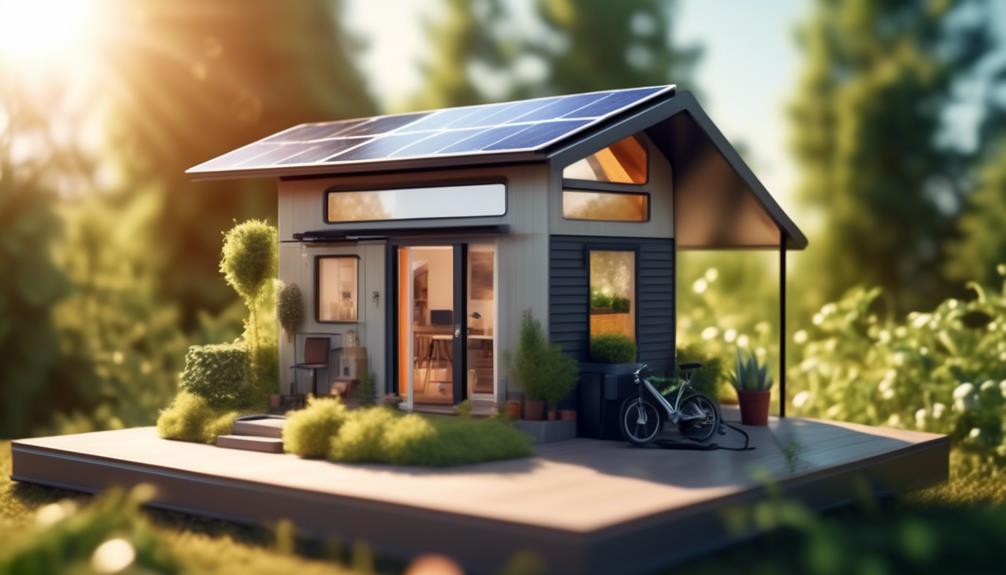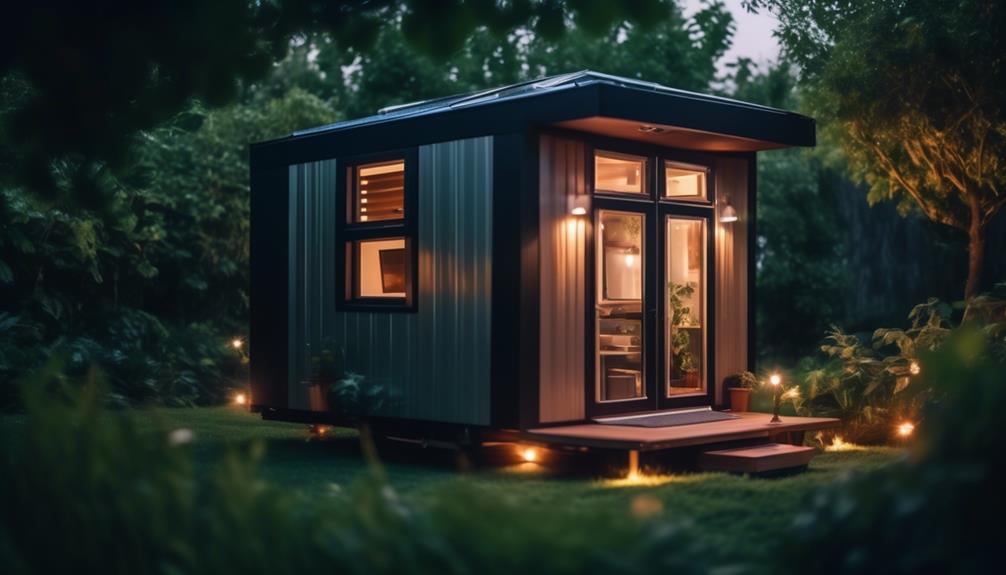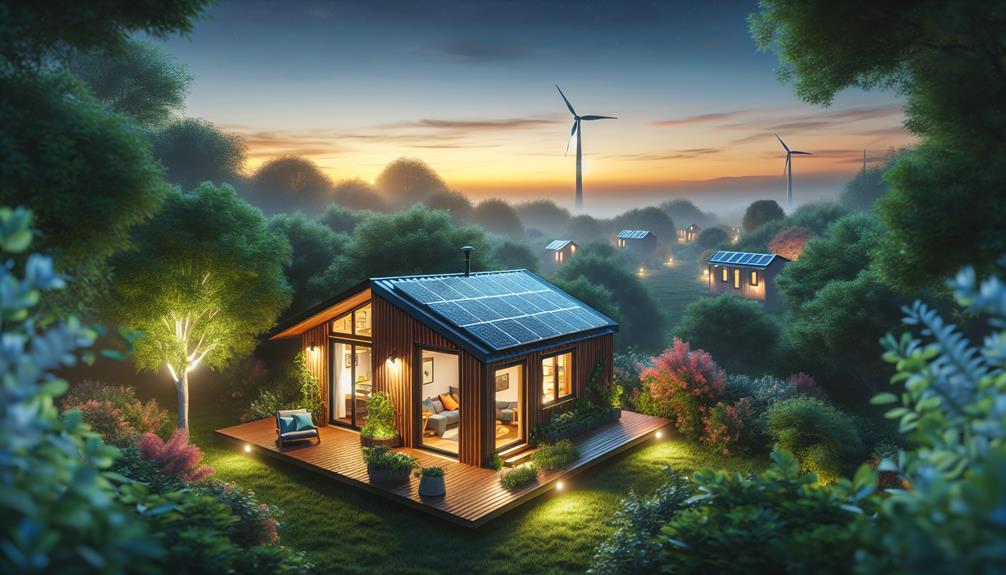Just as you're looking to downsize your living space, it seems the world is also shrinking its carbon footprint, making energy efficiency more important than ever.
You've chosen the tiny home lifestyle, which naturally consumes less energy, but there's a myriad of ways to push your eco-friendly living to the next level.
By exploring how to maximize your home's energy efficiency, you'll not only contribute positively to the environment but also significantly cut down on your utility bills.
I'll guide you through assessing insulation that keeps your space snug, selecting appliances that sip rather than gulp power, and implementing renewable energy sources that could potentially liberate you from the grid.
As you consider the benefits of a low-impact home, bear in mind that the choices you make now will resonate for years to come, promising a sustainable and cost-effective way of life that beckons with the simplicity and ingenuity of tiny home living.
Key Takeaways
- Understanding and prioritizing insulation is crucial for energy efficiency in a tiny home. Consider the R-value, balance insulation thickness with living space, prioritize air sealing, and insulate around heat-transmitting areas.
- Energy-efficient appliances can significantly reduce energy consumption in a tiny home. Look for appliances with the Energy Star label, consider compact options like induction cooktops and tankless water heaters, and opt for heat pump dryers and efficient dishwashers.
- Solar power is a sustainable solution for energy independence in a tiny home. Equip your home with solar panels, use solar batteries to store excess energy, and reduce reliance on conventional electricity sources.
- Maximize natural light in your tiny home through strategic window and skylight placement. Use reflective surfaces to amplify natural light, reduce reliance on artificial lighting, and improve energy efficiency.
- Implement water conservation systems to reduce water waste and enhance energy efficiency. Consider rainwater harvesting and graywater systems to reuse non-potable water, and integrate these systems into your tiny home to reduce water consumption.
Assessing Insulation Options
When selecting insulation for your tiny home, it's crucial to understand the R-value. The R-value measures how effectively the material resists heat flow. Higher R-value means better insulation, reducing the energy needed to heat or cool your space.
Thicker, higher-rated insulation options may seem ideal, but in a smaller space, you must balance between insulation thickness and living area. Prioritize air sealing to minimize air leakage, thereby enhancing energy efficiency.
Address thermal bridging by insulating around heat-transmitting areas to prevent heat loss. Explore eco-friendly solutions like spray foam or cotton insulation for sustainable energy savings. These innovative materials not only insulate but also contribute to a healthier living environment by regulating air movement and moisture.
Choosing Energy-Efficient Appliances
When outfitting your tiny home, selecting appliances with the Energy Star label is crucial for keeping your space green and utility bills low.
Consider compact options that don't skimp on efficiency, such as induction cooktops and tankless water heaters.
Compact Appliance Selection
To maximize your tiny home's energy efficiency, carefully select appliances that promise lower energy consumption. Induction cooktops and tankless water heaters are great options. Induction cooktops not only use less energy but also offer improved safety, making them a smart, eco-conscious choice. Tankless water heaters, which provide hot water on demand, significantly reduce energy costs by not maintaining a reservoir of heated water like traditional models.
When considering compact appliance selection, look for items with Energy Star certification. This ensures that your choices are environmentally friendly and will keep energy consumption to a minimum. Options for your tiny space might include heat pump dryers, which reuse hot air, and efficient dishwashers that save more water and energy than washing dishes by hand.
Energy Star Ratings
Harnessing the power of Energy Star ratings, you can select appliances for your tiny home that significantly cut down on energy use and decrease your carbon footprint. Certified by the U.S. Environmental Protection Agency, these appliances are a cornerstone of an eco-conscious lifestyle. They're not just energy efficient; they're a testament to your commitment to renewable energy and innovation.
- Maximize Savings and Sustainability:
- *Lower Energy Bills*: Energy Star appliances consume less power, meaning more money stays in your pocket.
- *Enhanced Insulation*: Pair with proper insulation for optimal efficiency in heating and cooling.
- Embrace Renewable Energy:
- *Solar Panels Compatibility*: Integrate with solar panels for a greener energy mix.
- *Air Conditioning*: Choose Energy Star-rated air conditioning for a cool, sustainable living space.
Implementing Solar Power Solutions

As an energy-savvy homeowner, you can equip your tiny home with solar panels to tap into the sun's abundant power and significantly cut down on your reliance on conventional electricity sources. Solar power not only aligns with the eco-conscious ethos of Tiny Home Living but also offers the allure of energy independence.
With solar batteries, you'll save homeowners from energy worries during cloudy days by storing excess solar energy for later use. This innovation isn't just for remote Tiny Homes for sale; it's for the average tiny dwelling seeking to reduce their carbon footprint.
Maximizing Natural Light
You can harness the sun's power beyond solar panels by strategically placing windows in your tiny home.
Consider using reflective surfaces to amplify the natural light that enters, reducing the need for electric lights during the day.
This approach not only brightens your space but also cuts down on energy consumption, aligning with your eco-friendly goals.
Strategic Window Placement
Maximizing natural light in your tiny home requires strategic placement of windows and skylights to reduce reliance on artificial lighting and improve energy efficiency. By embracing the sun's path, you can ensure your space is awash with daylight, using fewer lights during the day, and cutting down on energy use.
- Natural Lighting Benefits:
- *Fewer lights needed*: Less need for artificial lighting saves energy.
- *Less heat*: Smart window placement can bring in light while reducing heat gain.
- Strategic Placement Tips:
- *Use air flow*: Venting skylights can cool your home as heat rises.
- *Energy Star certified windows*: Protect against energy loss and maintain interior comfort.
Reflective Surfaces Usage
Harnessing the reflective power of surfaces can significantly amplify the natural light in your tiny home, making spaces feel larger and more inviting. Use strategically placed mirrors to direct sunlight into dim areas. Light-colored walls, ceilings, and floors will make your tiny home not only brighter but also more energy efficient, as they reduce the need for artificial lighting.
Consider the following options for tiny spaces to enhance natural light:
| Surface Type | Placement | Benefit |
|---|---|---|
| Mirrors | Walls opposite windows | Directs light to dark corners |
| Metallic Finishes | Decor elements | Adds sparkle and spreads light |
| Reflective Films | Window surfaces | Increases incoming light |
| Light Colors | Walls, ceilings, floors | Reflects light, retains less heat |
Adopting these measures will empower you to create small spaces that are both innovative and eco-conscious.
Utilizing Smart Home Technology

Incorporating smart home technology into your tiny home can significantly enhance energy efficiency by automating and optimizing everyday tasks. Here's how you can leverage this innovation:
- Smart Thermostats:
- Optimize heating and cooling; use less energy than the average American home.
- Track and adjust temperatures remotely for maximum efficiency.
- Motion-Sensor Light Bulbs:
- Illuminate spaces only when needed, reducing energy waste.
- Swap out traditional bulbs for energy-efficient LEDs that interact with smart systems.
Smart power strips and remote-controlled appliances also contribute to a more energy-efficient environment. By monitoring real-time energy usage, you're not just saving on bills; you're actively protecting the environment.
Embrace smart home technology to make your tiny home a model of eco-conscious living.
Exploring Water Conservation Systems
As you optimize your tiny home's energy usage with smart technology, consider how water conservation systems can further reduce your environmental footprint. Integrating options like rainwater harvesting not only bolsters energy efficiency but also harnesses a natural resource, trimming down your water waste.
Graywater systems enable the reuse of non-potable water for tasks such as irrigation, slashing your overall water usage.
Opt for drought-tolerant landscaping to minimize your tiny home's water demands. Such eco-conscious choices have a lesser impact on the environment and often require less energy.
Additionally, installing tankless water heaters and low-flow toilets and showerheads are energy-efficient practices that conserve water.
These water conservation systems in your tiny home ensure that your lifestyle remains as sustainable as possible.
Frequently Asked Questions
How Can We Save Energy in a Tiny House?
You can save energy in your tiny house by installing solar panels, using LED lighting, and conducting an energy audit. Upgrade insulation, apply window treatments, choose energy-efficient appliances, conserve water, and adopt behavior changes.
What Is the Cheapest Way to Power a Tiny House?
Harnessing solar panels and wind turbines is the cheapest way to power your tiny house. You'll save more by adding insulation upgrades, LED lighting, energy-efficient appliances, composting toilets, and rainwater harvesting systems. Conduct an energy audit!
What Is the Best Heat Source for a Tiny House?
You'll find solar panels and passive solar design top choices for heating your tiny house, combining eco-friendliness with innovation, while wood stoves and propane heaters offer reliable warmth with a smaller carbon footprint.
What Is the Best AC Unit for a Tiny House?
For your tiny house, choose a compact model AC with high energy ratings. Consider split systems for less noise and ease of installation. Ensure climate compatibility, use smart controls, and follow maintenance tips.
Conclusion
In the end, it's your footprint that matters. By cocooning your tiny abode in top-notch insulation, handpicking efficient appliances, harnessing the sun's power, and inviting daylight in, you've set the stage for sustainability.
Smart tech and water-wise systems are the cherries on top, ensuring every drop and watt counts.
Remember, living small doesn't mean thinking small—embrace these eco-wise choices, and watch your tiny home become a mighty bastion of energy efficiency.

